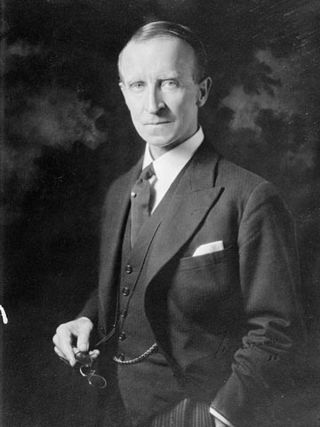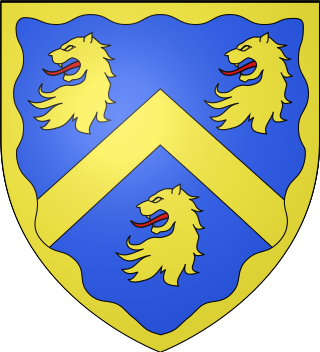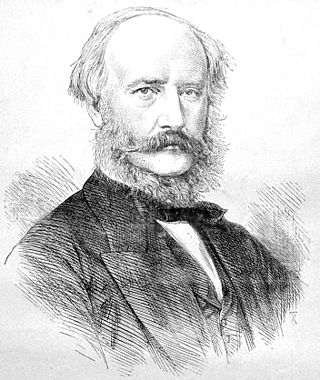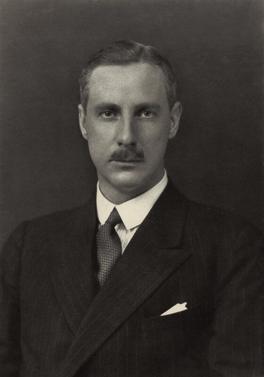Douglas, occasionally spelt Douglass, is a Scottish surname. It is thought to derive from the Scottish Gaelic dubh glas, meaning "black stream". There are numerous places in Scotland from which the surname is derived. The surname has developed into the given name Douglas. Douglas is a habitational name, which could be derived from any of the many places so-named. While there are numerous places with this name in Scotland, it is thought, in most cases, to refer to Douglas, South Lanarkshire, the location of Douglas Castle, the chief stronghold of the Lords of Douglas. The Scottish Gaelic form of the given name is Dùbhghlas ; the Irish-language forms are Dúghlas and Dubhghlas, which are pronounced. According to George Fraser Black, in southern Argyllshire the surname is an Anglicised form of the surnames MacLucas, MacLugash.

Earl of Dalhousie, in the County of Midlothian, is a title in the Peerage of Scotland, held by the Chief of Clan Ramsay.

Earl of Galloway is a title in the Peerage of Scotland. It was created in 1623 for Alexander Stewart, 1st Lord Garlies, with remainder to his heirs male bearing the name and arms of Stewart. He had already been created Lord Garlies in the Peerage of Scotland in 1607, with remainder to the heirs male of his body succeeding to the estates of Garlies. This branch of the Stewart family were distant relatives of the Stewart Kings of Scotland.

Earl Temple of Stowe, in the County of Buckingham, is a title in the Peerage of the United Kingdom. It was created in 1822 for Richard Temple-Nugent-Brydges-Chandos-Grenville, 2nd Marquess of Buckingham, who was created Marquess of Chandos and Duke of Buckingham and Chandos at the same time. In contrast to the Marquessate and Dukedom, which were created with remainder to the heirs male of his body only, the Earldom was created with remainder to (1) the heirs male of his body, failing which to (2) the heirs male of his deceased great-grandmother the 1st Countess Temple, failing which to (3) his granddaughter Lady Anna Grenville and the heirs male of her body, and then to possible younger daughters of Lord Temple and the heirs male of their bodies.

Baron Manners, of Foston in the County of Lincoln, is a title in the Peerage of the United Kingdom. It was created in 1807 for the lawyer and politician Sir Thomas Manners-Sutton. He served as Solicitor-General from 1802 to 1805 and as Lord Chancellor of Ireland from 1807 to 1827. Manners-Sutton was the fifth son of Lord George Manners-Sutton, third son of John Manners, 3rd Duke of Rutland. His elder brother Charles Manners-Sutton was Archbishop of Canterbury from 1805 to 1828 and the father of Charles Manners-Sutton, 1st Viscount Canterbury, Speaker of the House of Commons from 1817 to 1834. The first Baron's great-grandson, the fourth Baron, assumed the surname of Manners only. As of 2010 the title is held by the latter's grandson, the sixth Baron, who succeeded his father in 2008.
Viscount Colville of Culross, in the County of Perth, is a title in the Peerage of the United Kingdom. It was created on 15 July 1902 for the politician and courtier, Charles Colville, 10th Lord Colville of Culross. He had already been created Baron Colville of Culross, in the County of Perth, in 1885, also in the Peerage of the United Kingdom. As of 2018, the titles are held by his great-great-grandson, the fifth Viscount, who succeeded his father in 2010. The fourth Viscount was a judge and politician. Lord Colville of Culross was one of the ninety elected hereditary peers that remained in the House of Lords after the passing of the House of Lords Act 1999, and sat as a crossbencher.
Baron Hamilton of Dalzell, in the County of Lanark, is a title in the Peerage of the United Kingdom. It was created in 1886 for the Liberal politician John Hamilton. He had previously represented Falkirk and Lanarkshire South in the House of Commons and after his elevation to the peerage served under William Ewart Gladstone as a Government Whip from 1892 to 1894. His eldest son, the second Baron, was a Government Whip from 1905 to 1911 in the Liberal administrations of Henry Campbell-Bannerman and H. H. Asquith and also served as Lord Lieutenant of Lanarkshire. His nephew, the third Baron, was Lord Lieutenant of Surrey. As of 2010 the title is held by the latter's grandson, the fifth Baron, who succeeded his father in 2006.

Baron Strathclyde is a title that has been created twice in British history, both times in the Peerage of the United Kingdom. It was first created on 15 January 1914 when the politician and judge Alexander Ure was made Baron Strathclyde, of Sandyford in Lanarkshire. This creation became extinct on his death in 1928.

Baron Tweedsmuir, of Elsfield in the County of Oxford, is a title in the Peerage of the United Kingdom. It was created in 1935 for the author and Unionist politician John Buchan. He served as Governor-General of Canada from 1935 to his death in 1940. His eldest son, the second Baron, was the husband of the Conservative politician Lady Tweedsmuir. As of 2010 the title is held by the second Baron's nephew, the fourth Baron, who succeeded his father in 2008.

Baron Leconfield, of Leconfield, in the East Riding of the County of York, is a title in the Peerage of the United Kingdom. It was created in 1859 for Col. George Wyndham (1787–1869). He was the eldest illegitimate son and adopted heir of George Wyndham, 3rd Earl of Egremont (1751–1837), by Elizabeth Ilive, his future wife, from whom he inherited Petworth House in Sussex, Egremont Castle and Cockermouth Castle in Cumbria and Leconfield Castle in Yorkshire, all formerly lands of Josceline Percy, 11th Earl of Northumberland (1644–1670), inherited by Charles Seymour, 6th Duke of Somerset (1662–1748), on his marriage to the Percy heiress Elizabeth Percy (1667–1722) and inherited as one of the co-heirs of his son Algernon Seymour, 7th Duke of Somerset, 1st Earl of Egremont (1684–1750), by the latter's nephew Sir Charles Wyndham, 4th Baronet (1710–1763), of Orchard Wyndham in Somerset, who inherited by special remainder the earldom of Egremont. The 1st Baron's eldest son, the second Baron, represented West Sussex in the House of Commons as a Conservative. He was succeeded by his eldest son, the third Baron, who served as Lord Lieutenant of Sussex from 1917 to 1949. The latter's nephew, the sixth Baron, served as Private Secretary to Prime Minister Harold Macmillan from 1957 to 1963. In 1963, four years before he succeeded his father in the barony of Leconfield, the Egremont title held by his ancestors was revived when he was raised to the peerage as Baron Egremont, of Petworth in the County of Sussex. As of 2017 the titles are held by his son, the seventh Baron. Known as Max Egremont, he is a biographer and novelist.

The Hogg baronetcy, of Upper Grosvenor Street in the County of London, is a title in the Baronetage of the United Kingdom. It was created on 20 July 1846 for the lawyer and Conservative politician James Hogg. He was Registrar of the Supreme Court of Judicature and Vice-Admiralty Court in Calcutta for many years and also represented Beverley and Honiton in the House of Commons. His son, the second Baronet, was Chairman of the Metropolitan Board of Works in London from 1870 to 1889. On 5 July 1887 he was created Baron Magheramorne, of Magheramorne in the County of Antrim, in the Peerage of the United Kingdom, as part of the celebrations for the Golden Jubilee of Queen Victoria. The title is pronounced "Marramorn" and derives from a historic site in County Antrim near Larne.

David John Colville, 1st Baron Clydesmuir,, was a Scottish Unionist politician, colonial administrator, and industrialist. He was director of his family's steel and iron business, David Colville & Sons as well as the final Governor of Bombay.
This is a list of people who served as Lord Lieutenant of Lanarkshire.

Clan Douglas is an ancient clan or noble house from the Scottish Lowlands.
John Colville may refer to:

Charles William Wentworth Fitzwilliam, 5th Earl Fitzwilliam in the peerage of Ireland, and 3rd Earl Fitzwilliam in the peerage of Great Britain, was a British nobleman and politician. He was president three times of the Royal Statistical Society in 1838–1840, 1847–1849, and 1853–1855; and president of the British Association for the Advancement of Science in its inaugural year (1831–2).

Richard Kidston Law, 1st Baron Coleraine, was a British Conservative politician.
John Colville JP was a Scottish businessman and Liberal politician.

Ronald John Bilsland Colville, 2nd Baron Clydesmuir, KT, CB, MBE, TD, was a Scottish soldier and businessman. He notably served as Governor of the Bank of Scotland, Lord Lieutenant of Lanarkshire, and Captain General of the Queen's Bodyguard in Scotland. According to his obituary, he was described as "an outstanding and dedicated servant of Scotland. He was a gentleman of the old school with a genial wit and great generosity of spirit".
Captain Alexander Steven Bilsland, 1st Baron Bilsland, KT, MC, known as Sir Steven Bilsland, Bt, between 1921 and 1950, was a Scottish businessman and public servant.











